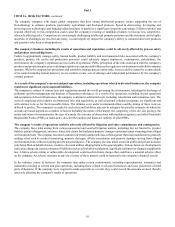DuPont 2013 Annual Report Download - page 17
Download and view the complete annual report
Please find page 17 of the 2013 DuPont annual report below. You can navigate through the pages in the report by either clicking on the pages listed below, or by using the keyword search tool below to find specific information within the annual report.
Part II
ITEM 7. MANAGEMENT'S DISCUSSION AND ANALYSIS OF FINANCIAL CONDITION AND RESULTS OF
OPERATIONS
16
CAUTIONARY STATEMENTS ABOUT FORWARD-LOOKING STATEMENTS
This report contains forward-looking statements which may be identified by their use of words like “plans,” “expects,” “will,”
“anticipates,” “believes,” “intends,” “projects,” “estimates” or other words of similar meaning. All statements that address
expectations or projections about the future, including statements about the company's strategy for growth, product development,
regulatory approval, market position, anticipated benefits of recent acquisitions, outcome of contingencies, such as litigation and
environmental matters, expenditures and financial results, are forward-looking statements.
Forward-looking statements are based on certain assumptions and expectations of future events which may not be accurate or
realized. Forward-looking statements also involve risks and uncertainties, many of which are beyond the company's control. Some
of the important factors that could cause the company's actual results to differ materially from those projected in any such forward-
looking statements are:
• Fluctuations in energy and raw material prices;
• Failure to develop and market new products and optimally manage product life cycles;
• Outcome of significant litigation and environmental matters, including those related to divested businesses;
• Failure to appropriately manage process safety and product stewardship issues;
• Effect of changes in tax, environmental and other laws and regulations or political conditions in the U.S. and other countries
in which the company operates;
• Conditions in the global economy and global capital markets, including economic factors, such as inflation, deflation and
fluctuations in currency exchange rates, interest rates and commodity prices, as well as regulatory requirements;
• Impact of business disruptions, including supply disruptions, and security threats, regardless of cause, including acts of
sabotage, cyber-attacks, terrorism or war, weather events and natural disasters;
• Ability to protect and enforce the company's intellectual property rights; and
• Successful integration of acquired businesses and separation of underperforming or non-strategic assets or businesses,
including proposed spin-off of the Performance Chemicals segment.
For some of the important factors that could cause the company's actual results to differ materially from those projected in any
such forward-looking statements, see the Risk Factors discussion set forth under Part I, Item 1A beginning on page 8.
Overview
Purpose DuPont’s businesses serve markets where the increasing demand for more and healthier food, renewably sourced
materials and fuels, and advanced industrial materials is creating substantial growth opportunities. The company’s unique
combination of sciences, proven R&D engine, broad global reach, and deep market penetration are distinctive competitive
advantages that position the company to continue capitalizing on this enormous potential.
Strategy Position DuPont as a higher growth, higher value company, well equipped to drive revenue and profit growth through
science-based innovation and the company’s significant competitive advantages with three priorities:
• Agriculture & Nutrition - extend DuPont’s leadership across the high-value, science-driven segments of the Agriculture
and Food value chain;
• Advanced Materials - strengthen the company’s lead as a provider of differentiated, high-value advanced industrial
materials;
• Industrial Biosciences - build transformational new bio-based businesses by combining DuPont’s world leading science
with expertise and resources from the Advanced Materials and Agriculture & Nutrition businesses.
The company is committed to maintain a strong balance sheet and to return excess cash to shareholders unless there is a compelling
opportunity to invest for growth.
Results Income from continuing operations after taxes increased 16 percent to $2.9 billion. Net sales of $35.7 billion increased
3 percent driven by 5 percent higher volume. Sales grew 6 percent in developing markets, which include China, India, and the
countries located in Latin America, Eastern and Central Europe, Middle East, Africa, and Southeast Asia. Sales of new products
introduced in the last four years also contributed to sales growth.
























